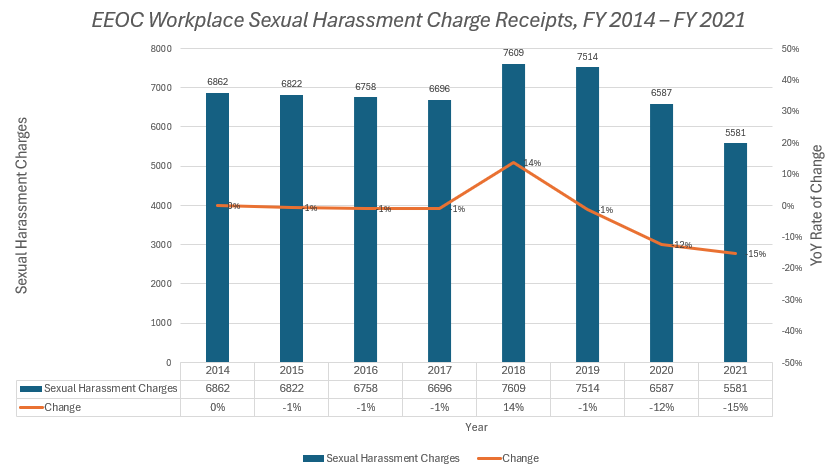Workplace sexual harassment in California is defined as any unwanted or inappropriate conduct or behavior that is based on the victim’s sex and creates a problematic work environment for the victim. Any incidents of sexual harassment violate Title VII of the Civil Rights Act of 1964 and California’s Fair Employment and Housing Act. There are many different ways in which sexual harassment can manifest in the workplace and it doesn’t always need to be overtly sexual in nature. Some ways may be obvious and direct which can cause a hostile work environment while other times an offender can be oblivious to the impact their behavior has on other people. Other incidents may be more subtle and harder to prove. Sexual harassment can be either physical or verbal and there are some things that may not seem like a big deal to many people but make an individual uncomfortable. One of the defining factors of sexual harassment is that it is unwanted conduct. A manager placing a hand on an employee’s shoulder may be an innocent gesture. But if the employee asks them not to do that and they continue to do so, it may constitute harassment.
What is Sexual Harassment in the Workplace?
Sexual harassment is considered sex based discrimination and includes any unwanted conduct that is based on the victim’s sex and would make any reasonable person uncomfortable at work [1]. The conduct also needs to be severe or pervasive in order to be considered harassment. While the behavior doesn’t always need to be sexual in nature, it often is. However, there are incidents of sexual harassment where the harasser’s behavior can be outright offensive or off putting without indicating a desire for sexual interaction. An example of this would be a harasser making an offensive comment about a woman and her attire.
If your employment rights have been violated, call us today at (866) 936 7349 to schedule a free consultation
Common Examples of Sexual Harassment in the Workplace

Sexual harassment is a term that encompasses a wide verity of behavior including but not limited to [2]:
- Unwanted touches
- Requests for sexual behavior
- Sexual bribery or blackmail
- Standing in someone’s personal space
- Grabbing or brushing against someone
- Sexual or degrading jokes and comments
- Telling explicit stories
- Sharing explicit pictures or videos
- Making offensive gestures
- Asking invasive questions
- Sending explicit messages
- Staring at someone
- Following someone
- Blocking someone
- Propositioning someone
- Hugs and backrubs
- Using inappropriate terms of endearment
- Commenting on someone’s appearance
- Commenting on someone’s body
However, sexual harassment is not always about sexual desire. Other examples of sexual harassment include but are not limited to:
- Making derogatory remarks about someone’s gender
- Asking a trans person about their anatomy
- Asking invasive questions about someone’s orientation
In order to be considered harassment, the behavior must be unwanted and pervasive. If the behavior is welcomed, or if the person is asked to stop the behavior and does, it may not qualify. Isolated incidents may be considered harassment if they are severe such as quid pro quo harassment.
Where Can Sexual Harassment Occur?
In general, sexual harassment can happen anywhere. In the workplace, personal sexual harassment such as advances tends to happen in one on one situations such as private meetings. Comments, propositions, photos, and videos may even be sent via email or direct messages. Generalized harassment just as derogatory comments or jokes may happen in more group settings such as a break room. Non work company functions such as office holiday parties can also be a common situation in which sexual harassment may occur due to a more relaxed setting and the possible addition of alcohol.
Can Sexual Harassment Occur in the Job Interview Process?
The law forbids employers from asking prospective employees about any protected category. This includes questions about sexual orientation, gender identity, marital status, or pregnancy. Employers are also not allowed to make employment contingent on sexual favors. While sexual harassment unfortunately can and does happen during the job interview process, it is still illegal.
What are the 2 Primary Types of Workplace Sexual Harassment?
In a work environment, sexual harassment is divided into two categories.
Quid Pro Quo – When a boss, manager, supervisor, or anyone with power over someone’s employment uses that power to try and leverage sexual favors. This may include offering benefits, setting conditions for promotion, or threatening adverse employment action if rejected.
Hostile Work Environment – When unwanted sex-based words or actions are extreme or consistent enough that it creates an intolerable work environment that negatively impacts the employee’s ability to do the essential functions of their job.
Though different, these categories may coincide in the same workplace and present their own challenges when faced with the burden of proof.
How Common Is Sexual Harassment in the Workplace?
Based on sexual harassment statistics provided by the Equal Employment Opportunity Commission, between 2018 and 2021, 35.4% of the charges they handled were for harassment, 27.7% of which were for sexual harassment [3]. They also reported that 78.2% of those charges were filed by women [4]. Nearly two thousand of the sexual harassment charges were accompanied by a racial discrimination charge with 71.2% of them listing Black/African American as the race in question. Nearly 800 of the sexual harassment charges were accompanied by a national origin discrimination charge, nearly half of which identified as Mexican or Hispanic. Furthermore, 43.5% of the sexual harassment charges also involved retaliation charges.
In the aftermath of the 2018 viral #metoo movement, workplace sexual harassment charges jumped by 14%. However, since then sexual harassment claims have dropped every year following the implementation of stricter guidelines, harsher punishments, better training, and increased awareness. According to the EEOC, 2021 reported a low of 5,581 claims which was the lowest number of claims seen since the data started tracking in 2014 [5].

Other Workplace Sexual Harassment Considerations
- Since sexual harassment is considered sex discrimination, it does not have to be explicitly sexual in nature or motivated by sexual desire. Harassment in the form of enforcing gender stereotypes, sexist remarks and actions, and invasive questions about someone’s sexual orientation or gender identity is still considered sexual harassment.
- Employers are not only responsible for refraining from committing sexual harassment, they are also expected to protect their employees from harassment by their coworkers or third parties such as vendors, clients, or customers. Employers must take steps to prevent sexual harassment such as providing training, and they must also take action when they are made aware of harassment occurring in the workplace.
- While women make up the majority of sexual harassment victims, it is a problem that faces all genders. Sexual harassment can occur in any combination including groups of people rather than one on one and it can be directed at a victim of the opposite or the same sex [6]. Anyone can be a perpetrator or a victim.
What Should You Do if You Have Been Sexually Harassed at Work?
When facing any kind of harassment at work, it is important to gather as much evidence as possible by keeping documentation and noting details of any incidents that occur. If someone does not realize that their actions are making people uncomfortable, the solution may be as easy as asking them to stop. If this does not work, the matter should be taken to management or human resources immediately. Employers have a legal responsibility to ensure that all their employees are safe from unwanted sexual harassment. If the matter cannot be resolved internally, a complaint can be filed with a government agency. It may also be wise to seek legal advice from an employment attorney.
If your employment rights have been violated, call us today at (866) 936 7349 to schedule a free consultation
Document the Sexual Harassment
Sexual harassment often happens in private, making it difficult to prove. It is important to document any incidents that occur. Be sure to note the:
- Date and time
- Names and location
- Words and actions
Try to note down what happened as soon as you can and be as detailed as possible. If the harassment is occurring via text or email, keep copies of all conversations. Sometimes, coworkers may notice what is happening and may be able to give witness testimony.
Check Employee Handbook and Report to HR
Companies should have their own guidelines and procedures for addressing workplace sexual harassment. These can often be found in the employee handbook or posted in the break room. There may be a specific department or portal for filing complaints. If the harassment is coming from a coworker or customer, the next step may be to alert your manager. If they cannot help, or the harassment is coming from a member of management, a formal complaint should be sent to human resources. The best course of action is to always submit written complaints via email so that you have a copy of the complaint and proof that it was sent and who it was sent to.
File a Complaint

If your employer does not address or resolve the issue, the next step is to file a complaint with the California Civil Rights Department (CRD) or the Federal Equal Employment Opportunity Commission (EEOC) [7]. This complaint should be filed as soon as possible and should be as detailed as possible. Oftentimes, a perpetrator will have more than one target. If multiple employees have been victimized, then it is encouraged for each of them to submit complaints. This can strengthen the validity of the claim and may help reduce possible retaliation from the employer. The EEOC will conduct their own investigation into the claim, and if they determine that the claim is valid, they will issue a right to sue letter.
How Much Time Does an Employee Have to File a Sexual Harassment Complaint?
There is a limit to how much time a person has to file a harassment claim. Complaints to the EEOC must be filed within 180 days of the last incident. In California, that time limit may be extended to 300 days if the person is also filing a complaint with the DFEH/CRD. Complaints to the DFEH/CRD must be filed within 3 years of the last incident. After a right to sue letter has been issued by the EEOC, the person has 1 year from the date it is issued in which to file a lawsuit. The time limit for filing a lawsuit after receiving a right to sue letter from the DFEH/CRD was extended from 1 year to 3 years in 2020.
Find Legal Representation
Workplace sexual harassment is a violation of both federal and California state law. When someone is sexually harassed at work, they have a right to not only seek help from designated government agencies, but also to file a lawsuit. While people are allowed to represent themselves, it is almost always better to have a lawyer. Even if you’re not sure whether or not your situation constitutes illegal sexual harassment, it can be beneficial to speak to an employment attorney and find out what your options are.
Employers Duty When Sexual Harassment is Reported
Employers have a responsibility to keep the workplace free of sexual harassment [8]. Harassment prevention training must be provided every year to all employees. Supervisory staff must undergo two hours of sexual harassment training and nonsupervisory staff must undergo one hour. There must be specific harassment prevention policies and procedures in place that are clearly provided to all employees and consistently enforced. There must be an accessible system for employees to report any instances of harassment. When an employee reports sexual harassment, the employer is required to conduct a thorough unbiased investigation in a timely manner. Appropriate action must be taken in order to resolve the situation. Employers are prohibited by law from retaliating against employees for making complaints.
Who Can Be Held Liable for Workplace Sexual Harassment?
While perpetrators of sexual harassment can be held liable for their own actions, in many cases, the employer may be found liable as well. If a company does not have proper harassment prevention procedures in place, does not provide harassment prevention training, or allows the harassment to continue, they can be found liable as well. Sometimes, there may be no way for an employer to know what is happening. This is why it is important to report the harassment to your human resources department. Employers can be held liable for sexual harassment that they did not commit if they knew it was happening or reasonably should have known it was happening.
What is the Difference Between Sexual Harassment and Non-Sexual Harassment?
Sexual harassment is sex based discrimination that manifests in pervasive or severe unwanted verbal or physical conduct. The harassment is sexual in nature but is not limited to sexual pursuit.
Non-sexual harassment is discrimination based on any other protected category such as age, race, religion, and disabilities. It is also pervasive or severe unwanted verbal or physical conduct and negatively impacts an employee’s ability to perform the essential functions of their job.
What is the Difference Between Sexual Harassment, Assault, & Misconduct?
Sexual harassment is a violation of civil laws. It consists of verbal conduct such as comments, passive conduct such as displaying explicit material, and minor physical contact such as rubbing someone’s shoulders. If you are the victim of sexual harassment, it is advisable to speak to an attorney.
Sexual assault is a violation of criminal laws. It consists of severe physical misconduct such as unwanted sexual contact and being forced to engage in sexual activity. If you are the victim of sexual assault, it is advisable to speak to the police.
Sexual misconduct is a violation of specific policies that a company has in place. It may include violation of civil and criminal laws as well as legal behavior. Many companies do not allow employees to engage in sexual relationships of any kind with each other or between management and staff.
If your employment rights have been violated, call us today at (866) 936 7349 to schedule a free consultation
Contact Mesriani Law Group if You Have Been a Victim of Workplace Sexual Harassment
Workplace sexual harassment is a violation of both federal and California state law. Although there are many regulations in place to prevent it, thousands of cases still occur each year. There are many steps that victims must take and time frames in which those steps need to be taken. Many people are discouraged to come forward because they don’t know their options, or they fear retaliation from their employer. Seeking advice from an expert sexual harassment lawyer can help make the entire process easier. Our firm specializes in discrimination, sexual harassment, and wrongful termination. If you have been the victim of sexual harassment in the workplace, call Mesriani Law Group for a free consultation. Our office is located in Santa Monica but we provide expert legal representation to all of Los Angeles and Southern California. Don’t suffer any longer if you’re a victim of workplace sexual harassment. Call us today!
Sources
[1] https://www.eeoc.gov/sexual-harassment [2] https://www.doi.gov/pmb/eeo/Sexual-Harassment [3] [4] [5] https://www.eeoc.gov/data/sexual-harassment-our-nations-workplaces [6] https://www.doi.gov/pmb/eeo/Sexual-Harassment [7] https://oag.ca.gov/workplace-sexual-harassment [8] https://www.equalrights.org/issue/economic-workplace-equality/sexual-harassment/
Workplace Sexual Harassment Example FAQs
What is an example of workplace harassment?
A manager continuously comments on an employee’s appearance and finds reasons to touch them. The employee expresses to the manager that this makes them uncomfortable and asks them to stop. The manager continues the behavior and escalates by beginning to send the employee lewd messages and explicit photos. The manager then offers the employee a promotion and a pay raise in exchange for sex. The employee refuses and is terminated the following week. The employee in this scenario could have a case for sexual harassment and retaliation.
How can you be sexually harassed in the workplace?
There are generally two categories of workplace sexual harassment. Quid pro quo harassment is when someone with power over someone’s job offers them benefits or advancement in exchange for sexual favors or threatens them with adverse employment action unless they provide sexual favors. A hostile work environment is when an employee is subjected to constant or severe conduct that negatively impacts their ability to do their job. This can include physical as well as verbal harassment.
What is the most commonly reported type of workplace harassment?
In 2018 alone, 7,609 charges of sexual harassment were filed with the EEOC, a 13.6% increase from the previous year, coinciding with the emergence of the #MeToo movement. According to a report from the EEOC, they received over 98 thousand charges of harassment between 2018 and 2021. Over 27 thousand of those charges were for sexual harassment. Though there has been a steady decrease since 2018 with only 5,581 charges filed in 2021, it is unclear if this is due to a decrease in sexual harassment or a decrease in reporting it. Nearly half of those sexual harassment charges were accompanied by a retaliation charge, though that percentage has been decreasing as well.
What are sexually inappropriate comments?
In a professional setting, any sexual comments may be considered inappropriate with the exception of industries where such topics are relevant to the work. When defining harassment, one of the key factors is that the conduct is unwelcome. This can come in the form of:
• Jokes or innuendo
• Derogatory comments
• Flirtation or advances
• Speculation about someone’s body








